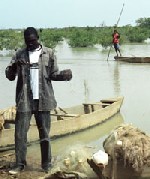|
afrol News, 24 September - The village of Sandago, deep in the dry savannah of Burkina Faso, bordered by ripe fields of millet and sorghum, has a new natural resource: a lake. Villagers now learn to use the new resources made available to them; to fish for food and profit. The water body formed behind an earth-and-concrete dam was built with village muscle power and material help from a church group. A permanent source of water meant farmers could cultivate larger fields of grain and vegetables. They also had a chance to catch the tilapia, catfish and other fish that occur naturally in the lake. The time had come not only to learn to fish, but also to manage the new resource so it would provide fish for years to come. The Sustainable Fisheries Livelihoods Programme of the UN's food agency FAO was there to help. The programme is dedicated to improving coastal and inland fisheries, which contribute to the livelihoods of 7 million poor people in 25 countries in West and Central Africa. During four-to-five-day training sessions, participants learn to think in a more sophisticated, holistic way about all the community's "livelihoods assets" - skills, infrastructure, savings and so on - for planning purposes. The goal is to let people, in partnership with government, co-manage their own resources, according to FAO. Sandogo's dam is only one of an impressive network of 2,100 dams in the country, built in low areas to harvest rain runoff for use during the cropping season. The dams have been built one by one with international assistance over the years since the devastating 1970-73 Sahelian drought and famine. Managing fish and crocodiles Getting started in the fishing business proved to be quite an adventure. "It was hard to learn how to fish," says Gabriel Sawadogo, introduced as the most successful fisher in the village. "For example, I had to first learn how to swim or else there is a risk of drowning if you tip the boat." In true cooperative fashion, villagers who knew how to swim taught non-swimmers how to stay afloat. Then there are the crocodiles. "A child lost his foot in an attack a while ago," says Tibo Zongo, group president. "And the crocodiles take our fish. Sometimes they damage our nets as they try to eat the fish that are already caught." Henri Zerbo, the Ministry of Fisheries engineer who oversees the project, adds that, to bring the crocodile population under control, the community might be able to get an exemption from wildlife legislation that protects the crocodiles.
- We've had some heated debates on the issue, he says. "In our culture, crocodiles are considered sacred. The villagers are now discussing whether the crocodiles in the reservoir, which are a new population that came down the river and into the lake, can be treated differently from the animals found on the other side of the village, where they have always lived," he says. Earning money during the dry season Fishing usually occurs during the dry season, when the fish are concentrated in a smaller amount of water and are easier to catch. Farmers, who in this season often need to sell grain from their precious stores for cash, are happy for the fish as an extra source of revenue. The grain can now be kept as a form of insurance for sale when emergencies arise, such as sickness in the family. Aline Zongo recalls how village women, who are responsible for processing the fish, used to treat the few fish caught in the river. "They ended up more grilled than smoked," she says. "Now we know how to smoke the fish properly. All in all, we are pretty pleased with the project. There is more money for our needs, for food and for the children." The Sustainable Fisheries Livelihood Programme works with local people to exploit Burkina Faso's water bodies. "We could have brought in professional fishers and harvested the lakes in a big way. But that wouldn't have done anything for the local community," concludes Mr Zerbo. Sources: Based on FAO and
afrol archives
|
front page
| news
| countries
| archive
| currencies
| news alerts login
| about afrol News
| contact
| advertise
| español
©
afrol News.
Reproducing or buying afrol News' articles.
You can contact us at mail@afrol.com


